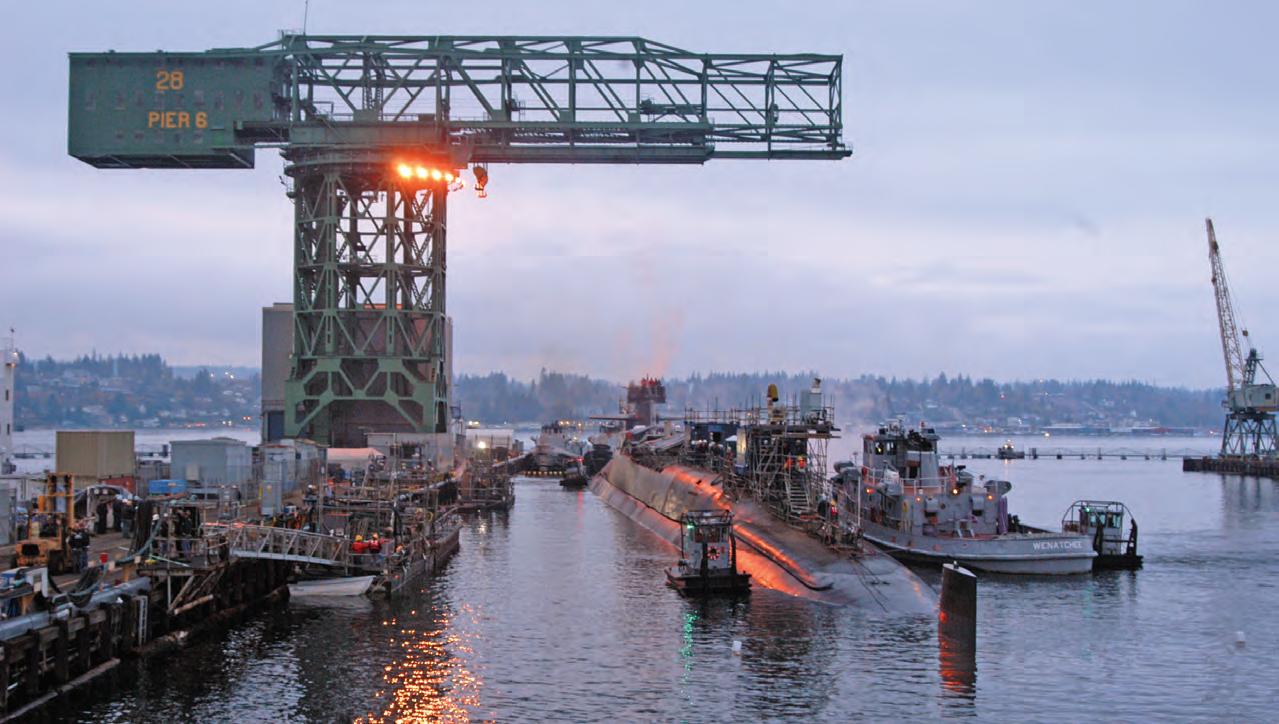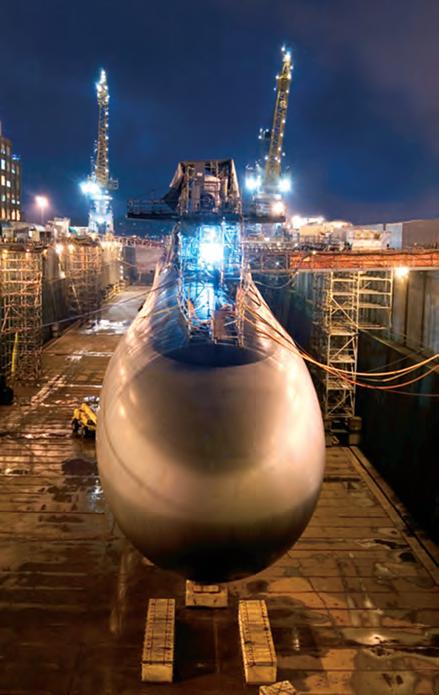
12 minute read
The SSGN Success Story: Concept to Capability in 39 Months
Photo courtesy of General Dynamics Electric Boat
Success Story
Advertisement
The SSGN
When the Navy decided to convert four older Trident ballistic missile submarines for conventional strike and Special Forces operations, the decision team was assembled that had to figure out how adjunct vehicles would take off and land from the superstructure of the converted ship. How would the fluid dynamics around the submarine change in response to a smaller vehicle approaching or being attached? How would the smaller vessel overcome turbulence and avoid being sucked into any other parts of the superstructure?
Concept to Capability in 39 Months
“There was quite a bit of engineering and analysis that went into that problem,” said Kirk Daniels, who was supervisor of naval architecture at General Dynamics Electric Boat in Groton, Conn., during the SSGN program. “We not only had to design it so the adjunct vehicles could be held on properly, but so they could be released and landed safely as well, and we needed to understand how it might affect maneuvering for the ship and the smaller vessel through all those steps.”
“This was an opportunity to show [our] expertise in computational fluid dynamics and other areas that just doesn’t exist anywhere else,” said Peter D. Canning, a naval architecture engineering manager at Electric Boat.
But the SSGN conversion program was about real estate management issues as much as complex computer modeling. When one puts seven TOMAHAWK cruise missiles into a single D-5 tube, it’s not enough to know that you have the space for the hardware. Seven times as many missiles means seven times as many cables to connect to a fire control system, which in turn requires significant changes to the missile tube itself.
In the past the penetration patches for that kind of a job would have been individually cut, drilled and then rolled into the desired shape, which would have been an enormous undertaking for the 88 tubes being reconfigured on the SSGN conversion program. Instead, designers came up with the idea ofrolling out an entire D-5 tube, and cutting the patches out of that.
“It saved us an enormous amount of time and work over doing them individually,” said Dexter White, an SSGN Conversion Site Manager in Norfolk, Va. “Because we were cutting them from a D-5 tube,weknewthey’dbetherightshape on the first try. It was ingenious. And yet it was so simple.”
Countless innovations, large and small, in engineering, manufacturing, planning, and production helped the SSGN conversion program become a model for Navy procurement, meeting or exceeding cost and schedule targets consistently. During the fall of 2007, the last submarine to be converted, USS Georgia (SSGN-729) was re-delivered and USS Ohio (SSGN-726) embarked on its first deployment.
“I’ve been involved with a lot of ‘firsts,’ but to be able to take something like the SSGN from a raw concept to delivery of the last boat was just incredibly rewarding,” White said.
The official timeline in the SSGN saga began Sept. 26, 2002, when the Navy contracted with Electric Boat for design and construction on the Ohio, USS Michigan (SSGN-727), USS Florida (SSGN-728) and Georgia. Ohio was re-delivered to the Navy just 39 months later, in December 2005, and commenced fleet operations in February 2006.
But the program had been in development much longer. In fact, Adm. Edmund P. Giambastiani, Vice Chairman of the Joint
Chiefs of Staff until his July 2007 retirement, was commodore of SUBDEVRONTWELVE in Groton when he wrote a paper for Adm. Bruce DeMars—then the Director of Naval Nuclear Propulsion—on conventional uses for Trident submarines.This was two years before the 1994 Nuclear Posture Review recommended reducing the size of the strategic missile submarine fleet from 18 to14.
The use of submarines in special operations dates back to Carlson’s Raiders in World War II, but reached a new level with the conversion of two earlier Benjamin Franklin-class “boomer” submarines, USS James K. Polk (SSN-645) and USS Kamehameha (SSN-642), in the 1990s. Polk was decommissioned in 1999 and Kamehameha, which still holds the record as the longest-commissioned nuclear submarine in the U.S. fleet (37 years), was retired in 2002.
But those conversions involved removal of the missiles and re-configuration for Special Operations Forces (SOF) troops. The current Trident submarine conversions will accommodate up to 66 SOF personnel for long durations, but also has additional capabilities that go far beyond that. Two ofthe 24 D-5 missile tubes, rebuilt as SOF lockout chambers, are designed to support adjunct vehicles or a dry-deck shelter, and the remaining tubes can be filled with seven TOMAHAWK cruise missiles each, giving the submarine the ability to fire up to 154 missiles in rapid succession. In addition, some of the tubes can be configured to allow experimentation with offboard vehicles, sensors, weapons and other payloads that will lead to even greater Submarine Force flexibility in the future.
The conversion program required extensive coordination between the design team and the two shipyards where the work was accomplished, Puget Sound Naval Shipyard for Ohio and Michigan, Norfolk Naval Shipyard for Florida and Georgia. “We created new teams of people with the right skills to go off and do this, and a new paradigm for getting it done,” said Tom Lyon, a
(Opposite) USS Michigan (SSGN-727) is shown in drydock during its conversion to an SSGN in 2006 at Pugent Sound Naval Shipyard, Wash. Michigan was redelivered to the Navy on Nov. 22, 2006. (Right) Electric Boat workers inside a missile tube of the Ohio as it is prepared for conversion to fire conventional missiles.
design program manager. “We didn’t use the traditional overhaul model. Electric Boat did the conversion and the shipyards did the refuelings concurrently, and we operated as a team. There was no traditional lead maintenance activity.”
Norfolk site manager, Dexter White, said given the short timeline for accomplishing the work, designers, shipbuilders and Navy personnel collaborated extensively on the design in order to make it easy to produce and to operate.
“We showed that the design-build process that pioneered with the Virginia-class program would save money and time, and in the end, we used a lot of the same methods that we did on USS Virginia (SSN-774). There’s no doubt in my mind that our experience on Virginia and our use of the design-build process were major factors in meeting the schedule, which was key to the success of the SSGN program,” White said.
Even a cursory look inside the submarine shows the extent of changes that has taken place. One major change was converting the navigation center into a battle management center that will allow command and control of forces ashore. But there have been thousands of smaller changes as well, from installing racks, desks, chairs and showers for the SOF troops, said Lyon.
“The Navy wanted extra exercise equip-
“We created new teams of people with the right skills to go off and do this, and a new paradigm for getting it done,” said Tom Lyon, a design program manager. “We didn’t use the traditional overhaul model. Electric Boat did the conversion and the shipyards did the refuelings concurrently, and we operated as a team. There was no traditional lead maintenance activity.”
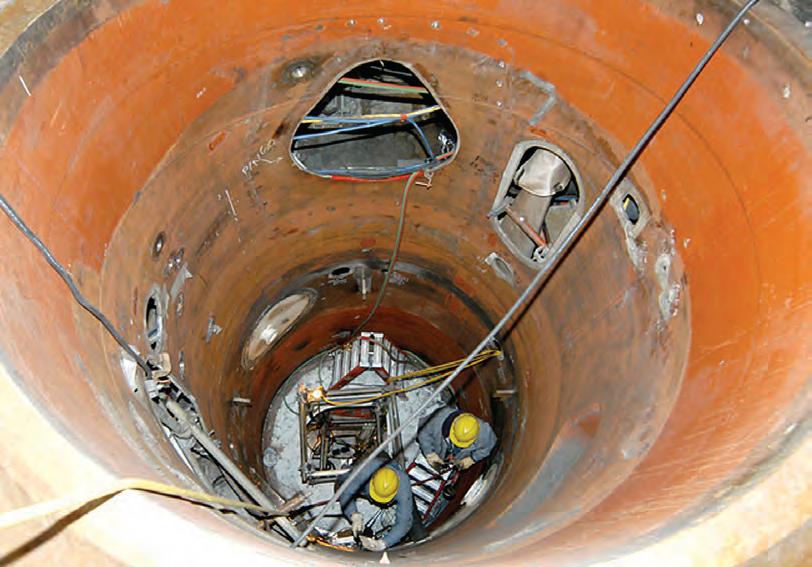
Photo courtesy of General Dynamics Electric Boat
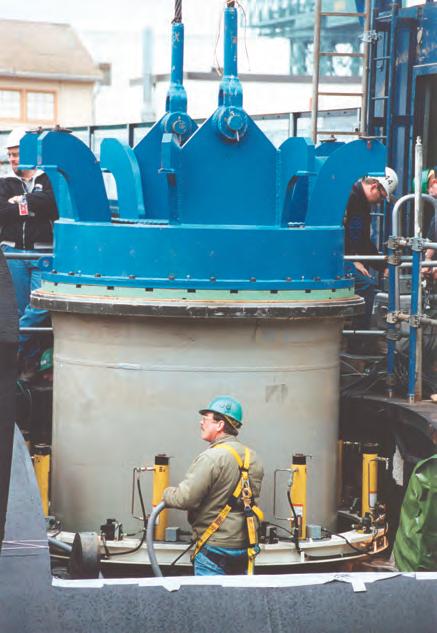
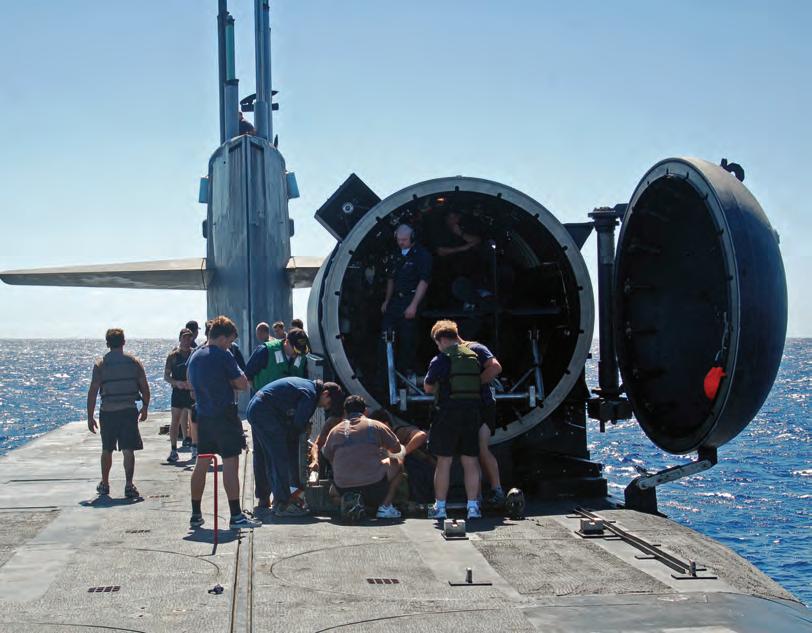
(Left) A lockout trunk is lowered into one of the missile tubes on Ohio. The lockout trunks will support covert deployment of Special Operations Forces from the submarines. (Right) Ohio conducted successful operational evaluation tests of the dry deck shelter, shown in this picture, and a swimmer delivery vehicle, which can be used to get Special Operations Forces on and off the ship in a covert fashion.
ment for the SOF personnel, so we had to make room for that, but we also had to go back and verify that the oxygen generators and carbon dioxide scrubbers had enough margin for the extra people, and even that the vents in the galley would be able to handle the extra cooking,” Lyon said.
In addition, new solid-state electronics replaced some of the older water-cooled computing equipment, which did not require as much ventilation. “Luckily, there was enough margin in the original design that we didn’t have to go back and change any of the legacy systems, but it got a very close look,” Lyon said.
A lot of the rules changed in the quarter-century since the four older Trident submarines were built, though, and the SSGN designers had to go back and certify that everything was safe and write new operating procedures where changes were made. If hangars were acceptable a foot apart when Ohio was commissioned in 1981 and new standards required them to be 8 inches apart, any modifications had to meet the new standards. In addition, Lyon said, there was an intensive survey of all four ships to make sure the construction crews understood any variation from the plan—in one instance, they found deck structures that were almost 2 inches lower than they should have been according to the blueprints.
“Everything was stick-built back in those days, especially the first of a class because it was being built as the design was proceeding,” Lyon said. “You knew you had a gauge here and a pipe there, and if you wanted to read the pressure in the pipe you ran a line between them. Today, the specifications are much tighter, and we model everything before it’s built. But we had to take a lot of ship checks to make sure we were engineering the SSGN to as-built conditions, not to the design that existed 20 years ago.”
But those ship-checks were fed into the CATIA (Computer Aided Threedimensional Interactive Application) model that was used to build the Virginia-class submarine, and today there exist exacting computer records of all four SSGNs, as-built.
As much as possible, designers also re-used existing equipment. The gas charging system used for ballistic missiles, for instance, was left about 80 percent intact, because it met the cleanliness and humidity requirements for a divers’ air charging system. In addition, designers adaptedthe D-5 tube to a two-chamber lock out truck, as opposed to a single chamber on the Virginia-class, which is wider and shallower, when modeling showed that the divers would get excessive turbulence from a single chamber when it was filled, similar to what happens when one turns a full soda bottle upside down.
Adapting the old systems meant extensive certifications across multiple disciplines to make sure that they were safe by modern standards. For the lockout trunks, for instance, the design had to be approved by 11 different Naval Sea Systems Command offices.
But even using modern materials, there are extensive certification requirements under the SUBSAFE program, noted Naval Architecture Supervisor Kirk Daniels. For instance, the converted ship was going to be considerablylighterwithout24D-5missiles aboard, and traditionally the way to make up for that is using lead ballast. Instead, the naval architecture team proposed the use of Ballast-crete.
“It’s a new material, never been used on a submarine before, so we had to come through a very thorough analysis of whether there would be any off-gassing from it, how it would respond to shock, that kind of thing,” Daniels said. “But we satisfied everyone that it was the right thing to do, and it really paid off. Not only was there a significant cost savings in material, but it installs a lot easier so it reduced the construction hours, and it’s more environmentally friend-
ly. It was a great decision for several reasons.”
Perhaps just as important was the personnel engineering that was required to accomplish the historic transformation of four ballistic-missile submarines into platforms unlike anything the Navy has ever put to sea.
“The fact that we had to set up two sites, one out west at the Puget Sound Naval Shipyard and one back east at the Norfolk Naval Shipyard, is something that’s often overlooked in terms of the major accomplishments on this project,” said EB’s Vice President for Maintenance and Modernization, Kevin Devine. “Crews were sent in to do this work while they had a refueling overhaul underway, and accomplished our work on time and on budget. At the height of the program we had upwards of 1,000 people at Puget Sound, which is like a small shipyard within the Naval Shipyard. We had security, we had quality, we had human resources and welders and planners, carpenters, everything needed to operate a self-sufficient team.”
That took extensive coordination with the shipyards that hosted the conversion starting months before the crews arrived so they would have the tool, parts and supplies required to jump right into the job. In addition, there were extensive briefings to employees as they arrived at the shipyards to make sure they understood the rules in their new location. At Puget Sound Naval Shipyard, for instance, there are no hard hats allowed in an eating establishment, and the gym is open for use only for dues-paying members.
“You go to a different location, and of course there are different rules, so there’s a lot of ‘people issues,’ that you have to overcome,” said Brian Wilson, the Puget Sound SSGN Site Manager. “But a shipyard is a shipyard, so you learn the new rules and you manage the work from there.”
In fact, the cooperation in the shipyard team paid off for Puget Sound when it had to do a D-5 backfit on USS Henry M. Jackson (SSBN-730). Missile tubes can get out of round because of the intense pressures of an undersea environment and in a refit might require re-boring. The design team had pioneered the use of commercially available boring machines on the tubes for the SSGN conversion, and realized significant savings—setup can be done in just four hoursinsteadof18 withtheoldequipment, and the boring takes place in four or five days on a single shift, instead of working round the clock 10 days. When the Henry M. Jackson job got underway, Puget Sound was using the commercial borer.
Finally, there was extensive communication between the operations at Puget Sound and Norfolk, including weekly teleconferences and a shared SSGN Lessons Learned database that was accessible at both sites. These communications were also coordinated with the material and ship’s test personnel who were headquartered in Groton.
“And at the end, the people who certified the ship ready to go to sea were back in Groton, so it all had to be done electronically. That’s probably the greatest success of the program, that we were able to manage the program at such a distance,” Devine said. “It’s incredible, what was achieved on this program.”
Mr. Hamilton is the Director of Communications for General Dynamics Electric Boat in Groton, Conn.
Ohio shown moored near a crane at Puget Sound Naval Shipyard, Wash., after it had been re-floated and was nearing the end of its SSGN Conversion. Ohio was the first SSGN redelivered to the Navy, on Dec. 11, 2005.
